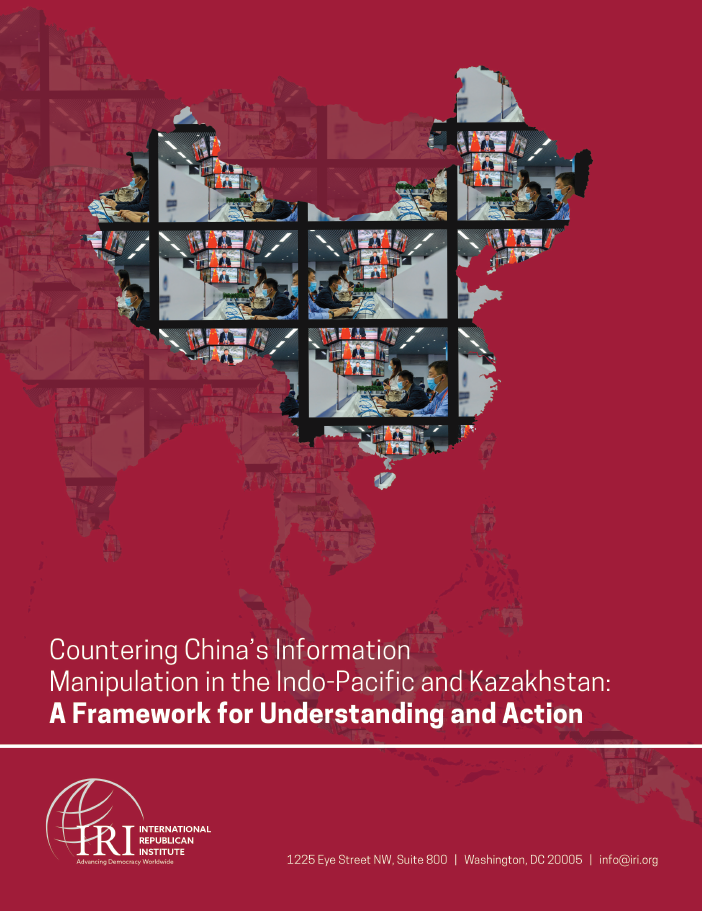Countering China’s Information Manipulation in the Indo-Pacific and Kazakhstan
A Framework for Understanding and Action

Although China’s ability to manipulate the global information environment has grown significantly in recent years, Beijing’s distinct approach – both globally and in the countries of the Indo-Pacific – remains poorly understood. This report sheds light on this approach by presenting an original analytical framework, one that argues the People’s Republic of China (PRC) approach to information relies on difficult-to-observe phenomena such as interpersonal diplomacy and the manipulation of economic incentives for societal elites, as well as high-profile phenomena such as social media bot networks or Confucius Institutes.
The report identifies this framework as a “united front approach” because it mirrors the “United Front” system the Chinese Communist Party (CCP) uses to maintain virtually unchallenged control of its domestic information space. The United Front operates domestically by shaping the interests of elite proxies – including leaders in business, media, and academia – through a combination of strong economic inducements and equally strong coercive techniques, co-opting them into aligning their public speech with the CCP’s preferred narratives. The report then applies this framework to explain how the fundamental principles behind this system – one that explicitly legitimizes unrestrained state coercion of societal elites outside China’s borders as a means to dominate narrative spaces – is applied to manipulate information spaces in the Indo-Pacific. This offers a deeper explanation of not just which techniques and targets the PRC chooses for information operations, but how and why it chooses them.
The report also argues that the PRC takes this approach because it views the ability to successfully manipulate information spaces in the Indo-Pacific as vital to regime security. Under current CCP General Secretary Xi Jinping, Beijing has said the PRC’s lack of international “voice” is as damaging as China’s 19th Century colonization by European powers. The PRC thus focuses on how to counter perceived challenges around its periphery, particularly in territorial disputes in the South China Sea and on its Himalayan border with India, or in Kazakhstan to stem the supposed threat of Uyghur “separatism”. In all these situations, the PRC leadership links its preferred policy outcomes with acceptance of its preferred framing of events, concepts, and policies, thus making its pursuit of a stronger regional “voice” inextricable from its security and economic objectives in the Indo-Pacific region.
The report details how the PRC pursues these information shaping objectives along its periphery through a wide variety of actors within and without the party-state. These include traditional government agencies like the Ministry of Foreign Affairs, but also includes CCP bodies such as the Ministry of Propaganda, and the United Front Work Department. The party-state also goes well beyond other governments’ normal diplomatic messaging efforts through its maintenance of a vast array of state-managed “friendship” organizations, which are meant to convene PRC-friendly actors in target countries under the banner of nominally “independent, non-governmental” organizations. Targets for these organizations include both the Chinese diaspora and non-Chinese societal elites. Distinct from many other states’ normal practice, the PRC also draws government and party bodies not traditionally associated with diplomacy and external messaging – such as the Ministry of Trade, the Ministry of Finance, the Ministry of Education, and others – into the work of incentivizing foreign elites to propagate its preferred narratives. Understanding the PRC’s information manipulation requires recognizing this division of labor, as well as recognizing the ways it is distinct from the way democratic states pursue their messaging objectives.
Top